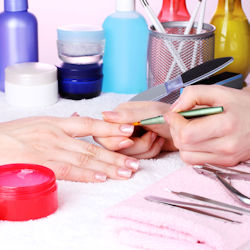Identifying Hazards
Introduction
The two most common types of hazards in the nail salon are chemical and biological hazards. In this module you will be introduced to these hazards and how to reduce exposure to them.
Chemical Hazards
Products used in nail salons may contain chemicals that can affect worker health. Using these products can expose nail salon workers to chemicals. Workers may breathe in the harmful vapors, dusts, or mists; get the product on their skin or in their eyes; or swallow the product if it is accidentally transferred onto food or cigarettes.

Chemicals affect different people in different ways. Many factors play a part in whether you get sick from contact with chemicals, including
- Toxicity - the kind of chemical you are exposed to,
- Dose - how much of the chemical you contact,
- Duration - how long the exposure lasted,
- Frequency - how often you were exposed,
- Route of entry - how it entered your body, and
- Fitness - your physical and psychological health.
Chemicals are absorbed into the body through four primary routes of entry:
- Inhalation - breathing in vapors, dusts, or mists from the products. Absorption occurs primarily in the lungs. Inhalation is the most common route of entry.
- Contact - directly touching the chemical. Absorption occurs primarily through the skin and eyes.
- Ingestion - swallowing the product if it gets on your uncovered food, drink, or cigarettes. Absorption occurs in the throat, stomach, and in many internal organs and systems.
- Injection - getting punctured or cut by sharp objects like broken glass, needles, or knives. Absorption occurs at the point of contact.
Exposures can "add up," especially when many products are being used at the same time, when the products are used day after day, or when there is poor ventilation in the salon. You can get sick right away (acute affects), or you can get sick over time (chronic affects). If you use chemicals all day, every day, you are more likely to get sick than someone who uses the same chemicals once in a while.
Knowledge Check Choose the best answer for the question.
1-1. What is the most common hazardous chemical route of entry?
You forgot to answer the question!
